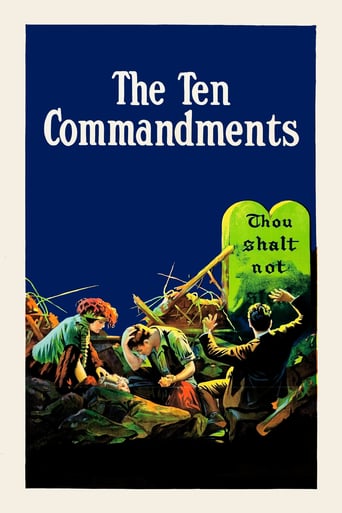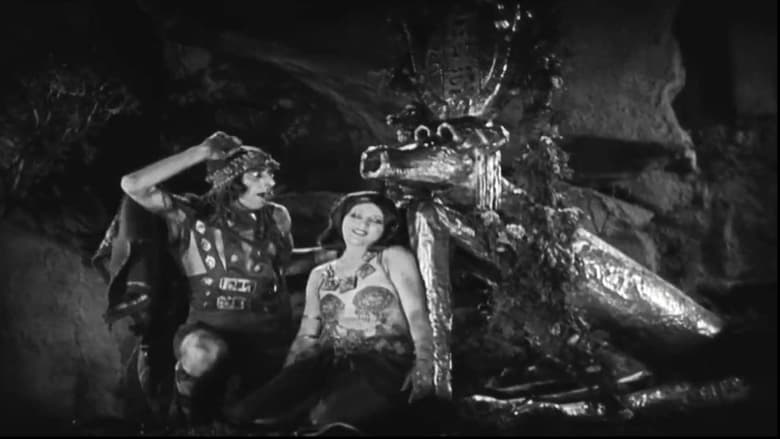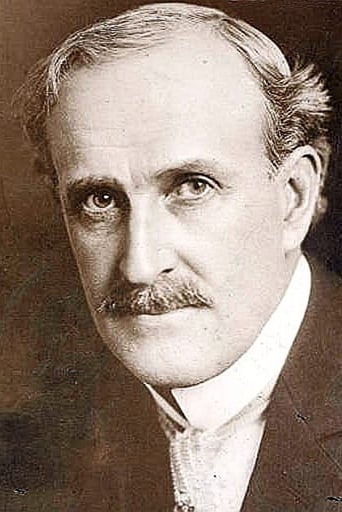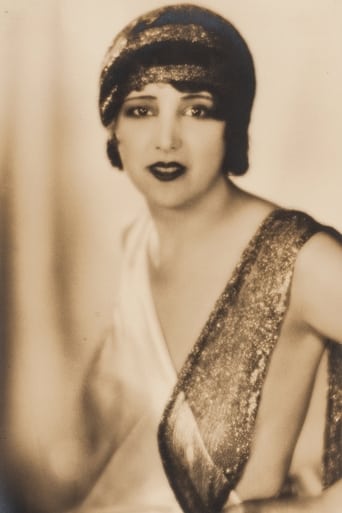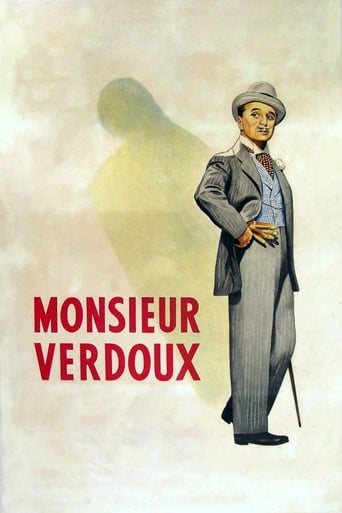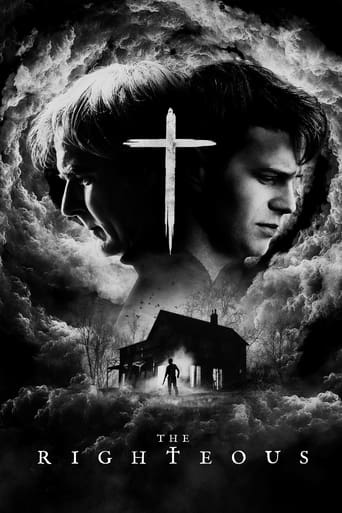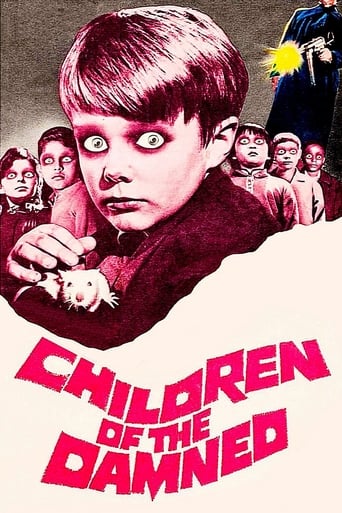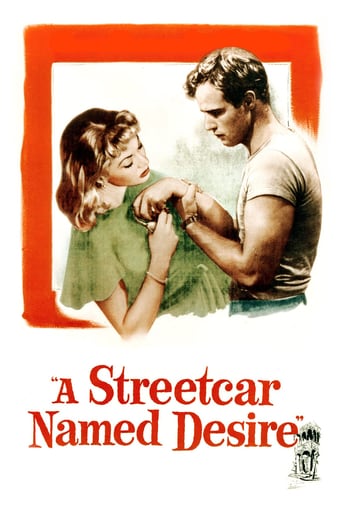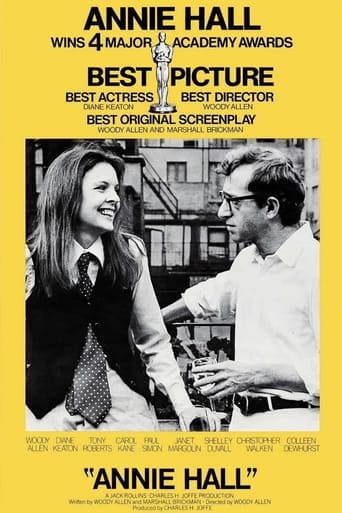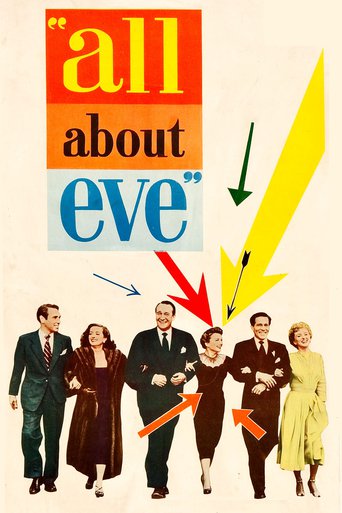The Ten Commandments (1923)
The first part tells the story of Moses leading the Jews from Egypt to the Promised Land, his receipt of the tablets and the worship of the golden calf. The second part shows the efficacy of the commandments in modern life through a story set in San Francisco. Two brothers, rivals for the love of Mary, also come into conflict when John discovers Dan used shoddy materials to construct a cathedral.
Watch Trailer
Cast


Similar titles
Reviews
When I reviewed "The Ten Commandments" (1956), I received a lot of 'Not Helpful' ratings. I assume this is because, unlike the average review, I did NOT particularly like the film and said so. Once again, I buck the crowd as I definitely did NOT like this previous version as well. In the case of both films, I seriously wonder whether or not the movies actually were a boon to atheists because the films were so incredibly bad--even with the incredible Egyptian sets.Unlike the more famous 1956 version, only the first 56 minutes of the film are about the Jews and the creation of the Commandments. The biggest differences you'll notice is that Moses is a very superficial character--and has very little to do in most of the film. In addition, the Children of Israel actually leave Egypt about 20-25 minutes into the film--and it's a 136 minute film. The rest of the film is actually set in the present day (1923) and is a very, very heavy-handed morality tale with absolutely no hint of subtlety--none. It comes on so strong and heavy-handed that I am sure many will laugh at its histrionics and silly plot.So what is to like about this film. Well, first and foremost, the DVD copy is perhaps the most pristine I have ever seen in a silent film--it's very, very crisp and clean. And, the Egyptian sets (as I mentioned above) are very nice. Apart from that, the rest is just pretty silly. The famed parting of the red sea looked like melty jello. And, imagine my surprise when I later read on IMDb that's really all it was!!! And, as for the story it was bad in two serious ways. First, the creation of the Commandments section was just too superficial and dispassionate--like the folks are acting out some half-baked passion play--where they really aren't too concerned with quality--just getting the stupid thing done! Second, the modern portion is much worse with it's message that comes across with all the subtlety of a 2x4 upside your skull!! As a result, unless you are a die-hard silent film fan or an atheist who hates God, don't bother with this silly film. Why Cecil B. DeMille has somehow been considered a genius for his (anti-) religious epics, I have no idea! By the way a few final thoughts. First, despite both of DeMille's films saying to the contrary, archaeological evidence AND written accounts of the day indicate the Jews did NOT build the pyramids but professional builders. Second, why did the Godly mother die in the film?! Didn't this seem to reinforce the notion that God is not real?! Talk about an illogically constructed religious message!! Though, now that I think about it, illogic was DeMille's forte--with nudity and bestiality in his other 'religious' epic "Sign of the Cross"!! And, though it was NOT a DeMille film, think about the original "Ben Hur"--as in the end, Jesus STAYED DEAD!!! What a whacked out message! All very Pre-Code in their sensibilities and all CLAIMING to be family religious entertainment!
Director: Cecil B. Demille, Script: Jeaine Macpherson, Cast: Theodore Roberts (Moses), Charles de Rochfort (Rameses), Estelle Taylor (Miriam,sister of Moses), Julia Faye (wife of pharaoh), James Neill (Aaron), Edythe Chapman (Mrs. Martha Mc Tavish), Richard Dix (John,son), Rod La Rosque (Dan,son), Nita Naldi (Sally Lung,Eurasian)Most people today have probably never seen this film. It is now available on the 50th anniversary set with the 1956 version. The 1956 version was an amazing movie but in many ways I prefer this one, Cecil B Demille's 1923 original. Many people will be surprised upon first viewing of this film. Demille uses a different approach thin in his 1956 remake. This film has two parts. The first part is set during the time of the exodus in the old testament. The Hebrew nation is enslaved by the Egyptians under the ruthless rule of the pharaoh Rameses. Moses as the chosen leader of the Jews frees his people from the Egyptians. God gives him the power to inflict plagues upon the Egyptians. He then leads his people on the great exodus across the desert to the Red Sea. God gives him the power to part the sea so the Jewish people can cross. Phaorah orders his army to go after the Jews across the parted Red Sea but God had the sea 'return to normal' so the army drowns.Make no mistake, this film was a major production in its day and very high budget for its time. Demille uses very elaborate sets for this production. The exterior wall of the great Egyptian city is just like the one used in the 1956 version. Many extras were used in the making of this film. During the great exodus, there appears to be people for as far as the eye can see. You can see this great line of people spread out across the desert. Camels were seen during the exodus but as it turns out, camels were not in the middle east during that time period. The parting of the Red Sea in the 1956 version was considered an amazing special effect for its time. I was very curious as to how they would be able to pull this off in 1923! I was quite amazed!! The special effects used for the parting of the sea is just as good as the 56 perhaps better. One thing I really like about the special effects of this film is the wall of fire that Moses creates to keep the Egyptian army at bay. In the 56 version animation was used for the fire. In this version real fire was used using a double exposure technique that I thought was more impressive. Mr Demille was very loyal to his actors. He would use many of the same actors in a number of his films. The women who plays the part of pharaoh's wife and the boy that played his son are both involved in the 56 version as well as the film editor.The film switches gears totally for the second half. We are now in modern times. It starts with a mother reading passages from the book of Exodus to her two sons. All the drama from the first half was simply her reading being acted out. The rest of the film is a morality tale between two sons. The mother and one son are deeply religious while the other son is a nonbeliever. He makes fun of his brother's silly beliefs so the mother kicks him out of the house for being a heathen. The believing son lives a modest life while the unbelieving son becomes very wealthy. He even gets the women they both like! He becomes a wealthy contractor employing his brother as a worker. However, the unbelieving brother's life will be filed with misfortune eventually leading to his death. The twist in the second half of the film makes for a interesting viewing experience. I like the contrast between ancient and modern times. Katherine Orrison in her commentary states that the modern sequence will probably seem more dated to the average viewer. I tend to agree. It is interesting to see how people lived and dressed during those times. The modern sequence is filmed mostly on location in San Francisco. It is cool to see how San Fran looked back then. The generation gap between the mother and her sons is very evident. This was the roaring 20's! Katherine Orrison gives an insightful commentary on both films but see seems to have a special fondness for this one. I can understand why.
Sunday January 8, 4:00pm The Paramount Theater, SeattleCountless slaves pull a gleaming white sphinx, inch-by-inch, across the desert sands. Brutalized by their cruel Egyptian masters, The Children of Israel toil before the monumental city gates of Pharaoh Rameses II. The opening scenes of Cecil B. DeMille's 1923 epic "The Ten Commandments" represent the historical spectacle of Hollywood's silent era at its grandest and most expressive. DeMille blended the intensely dramatic performance of his actors with the spectacular architecture of his sets in a way that seemed to bring the past to life for the movie going audience. His exhaustive research and striving for authenticity was limited only by his personal satisfaction. Of the roughly 2500 extras used one tenth were orthodox Jews from Los Angeles, many, recent immigrants who felt they were living the history of their ancestors. The flight from Egypt includes the added surprise of two-color Technicolor while the scenes of decadence as the Golden Calf is worshiped by an undulating mob are as vibrantly electric as any ever filmed. To be fair, it bears pointing out that the forty-five minute Ancient Egypt portion of "The Ten Commandments" is only a prologue to the modern story, which today seems dated and irrelevant. Two brothers, one good and one evil, alternately respect and defy the ancient laws of Moses and live with the consequences. The San Francisco setting may be of interest to anyone with ties to "the city by the bay", specifically the 1920's North Beach neighborhood, Saints Peter and Paul Church and Washington Square Park which are all prominently featured. Sexy Nita Naldi is also delightfully vampish as the heavy-lidded other woman draped in furs. The Jeanie Macpherson screenplay attempts to draw parallels between the story of Exodus and modern life, much more successfully accomplished in Michael Curtiz 1928 epic masterpiece "Noah's Ark", but the jazz age story can't hold a candle to the grandeur of the ancient world. DeMille's original does succeed if compared to the bloated, boringly over-detailed story and hammy acting of his 1956 remake. The 1923 prologue is concise, well paced and beautifully executed. The ancient Babylon of D. W. Griffith's 1916 spectacular "Intolerance" appears staged and remote when compared to a genuine sense of seeing and feeling the "hear and now" conjured up by DeMille's City of the Pharaoh. Hollywood produced progressively greater and more fantastic historical epics as the era drew to a close, including the MGM spectacle "Ben Hur" in 1925 and DeMille's "King of Kings" in 1927." the spirit of the spectacle, and the joy taken in its own magic, was unique to the silent film." - William K. Everson
It's interesting just to watch DeMille's first, silent film version of "The Ten Commandments", and the picture itself is pretty interesting too. It is also occasionally impressive, sometimes with the kind of DeMille flourishes that one expects, sometimes with a satisfying dramatic turn. It's quite different in its conception from the more familiar 1950's version, and so direct comparisons are not always possible, yet it holds up well by itself anyway.Rather than concentrating on the biblical story, as in the remake, here DeMille first tells an abbreviated version of the Moses/Exodus narrative, and then uses it as the thematic basis for a modern morality tale. There are many parallels between the two stories, and while the parallels are occasionally forced, they often work surprisingly well. The modern-day story is similar to many other films of the 1910's and 1920's, but it is interesting and it is told well.Although DeMille is known for his lavish spectacles, he also knew how to create some more subtle effects when he wanted to. In the modern story, some of the developments are a bit contrived, but the characters generally ring true, and the story itself is worthwhile as well. While the lavish remake with color and sound is probably going to remain more well-known, this earlier version is well worth seeing, too.

